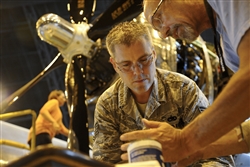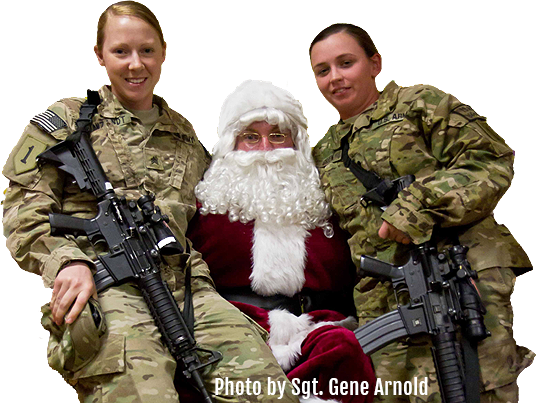 PHOTO: Air Force Tech. Sgt. Geoffrey Jensen places a cap on a fuel booster pump of a B-29 Superfortress he is restoring with other volunteers inside a Boeing hangar in Wichita, Kan., July 22, 2014. MCCONNELL AIR FORCE BASE, Kan. – As a child, he spent countless hours drawing aircraft from his World War II book collection, daydreaming about what it would like to be fly in one of them. The volunteers are restoring one of the last two B-29s to flying condition. U.S. Air Force photo by Airman 1st Class John Linzmeier Now, as an adult with 19 years of Air Force service, his aircraft dreams are still alive and are even more vivid as he spends much of his free time restoring one of the last flyable B-29 Superfortress bombers. Tech. Sgt. Geoffrey Jensen, 22nd Maintenance Group logistic resource management program noncommissioned officer in charge, became a volunteer for the “Friends of Doc” restoration project in March and has been hooked on helping ever since. Doc, a B-29 named after a character from the fairy tale "Snow White," was built in Wichita, Kansas, during World War II.
PHOTO: Air Force Tech. Sgt. Geoffrey Jensen places a cap on a fuel booster pump of a B-29 Superfortress he is restoring with other volunteers inside a Boeing hangar in Wichita, Kan., July 22, 2014. MCCONNELL AIR FORCE BASE, Kan. – As a child, he spent countless hours drawing aircraft from his World War II book collection, daydreaming about what it would like to be fly in one of them. The volunteers are restoring one of the last two B-29s to flying condition. U.S. Air Force photo by Airman 1st Class John Linzmeier Now, as an adult with 19 years of Air Force service, his aircraft dreams are still alive and are even more vivid as he spends much of his free time restoring one of the last flyable B-29 Superfortress bombers. Tech. Sgt. Geoffrey Jensen, 22nd Maintenance Group logistic resource management program noncommissioned officer in charge, became a volunteer for the “Friends of Doc” restoration project in March and has been hooked on helping ever since. Doc, a B-29 named after a character from the fairy tale "Snow White," was built in Wichita, Kansas, during World War II.
It has been parked inside a Boeing hangar next to McConnell Air Force Base, close enough for Jensen to do a little work during his lunch break, something he does frequently. “It’s like bringing history to life,” Jensen said. “There are a lot of people who have never even heard of this airplane. It’s the same model that dropped the atomic bomb and ended World War II, and it’s so cool that I get to be a part of that.” Working on an aircraft is nothing new to Jensen. He was a flightline crew chief for 18 years and has brought all of his experience with him to aid the restoration project. But he’s not the only one involved in the project who has military experience. “We’ve got a large number of veterans helping out here, including a 95-year-old,” said TJ Norman, volunteer manager. “It’s so nice having these Air Force guys over here, because all I have to do is show them what project we are working on, and they know exactly what to do.” The aircraft is being pieced together to resemble its original image with a few modifications for increased safety. Jensen said he has helped to implement modern avionics technologies while trying to maintain the aircraft’s originality.
Jensen’s enthusiasm for the restoration project has spread to other members of his family. His wife is helping to manage operational aspects of Project Doc, and even his father has joined him on a few occasions. “When my dad helped me install the pilot seat, he said that it was one of the best days he’s ever had, because he was able to help restore it and we worked on it together,” Jensen said. Doc’s restoration in Wichita began 14 years ago, and the airplane has been grounded for more than 50 years. Thanks to sponsors and the support from Jensen and other volunteers, the project is on track, Norman said, with the first test flight planned for late October or early November. While he has spent his entire Air Force career working on the maintenance side of flying operations, Jensen said, he is aiming to become a part of Doc’s aircrew after he retires in April. “We want to try to get him in as a flight engineer, which is the most important job on this airplane,” Norman said. Out of the six crew members needed to fly a B-29, the flight engineer is the one who is responsible for controlling the throttles, monitoring engines and fuel and more. The volunteers still have a lot of work to do for the B-29 to take flight again, Jensen said. Still, he added, he is honored to be a part of the effort of bringing history to life. “I’m trying to do as much work as I can on it,” he said. “It’s a huge, prideful thing to do. This truly is a once-in-a-lifetime opportunity.”
Written July 25, 2014 By: Air Force Airman 1st Class John Linzmeier 22nd Air Refueling Wing Republished and redistributed by permission of DoD.






